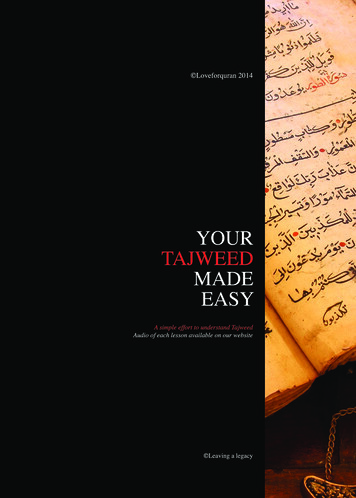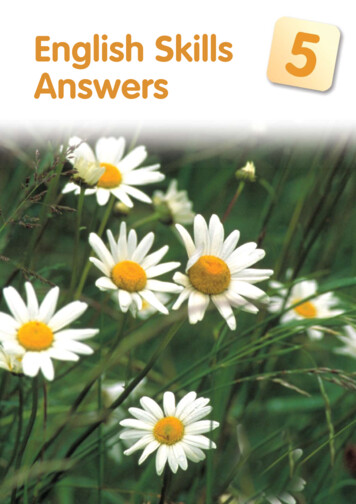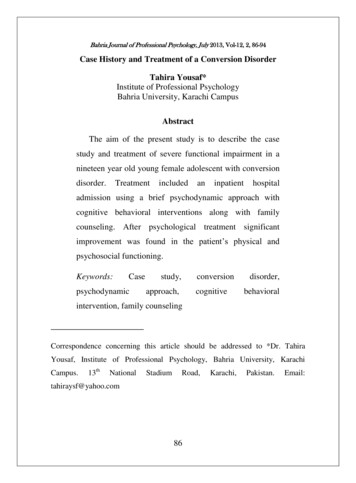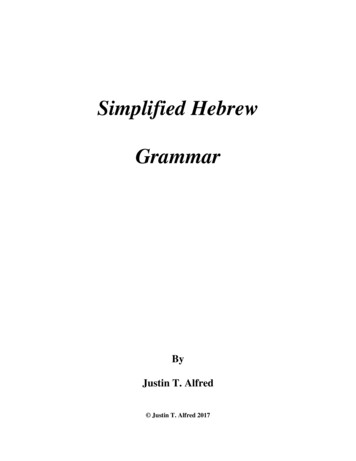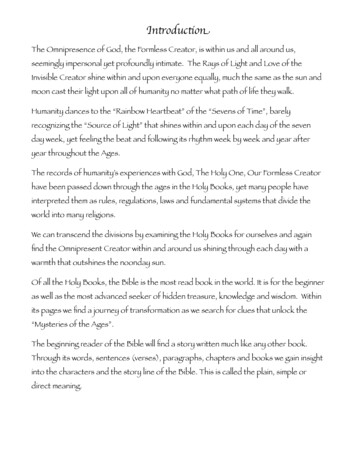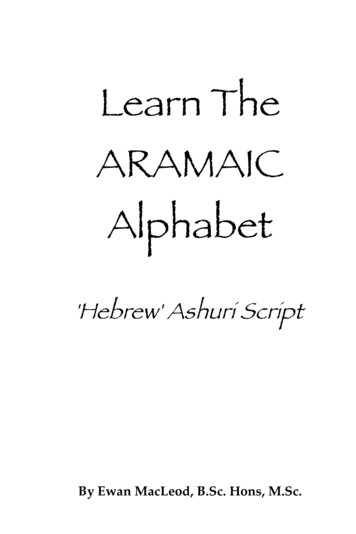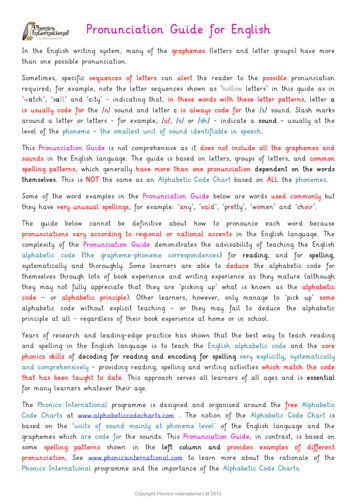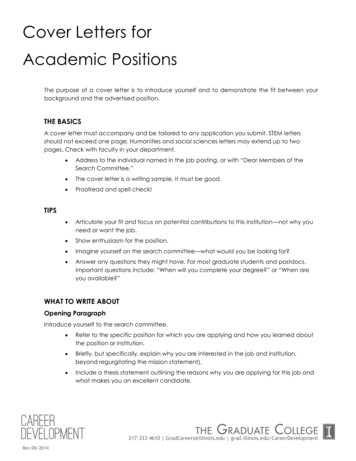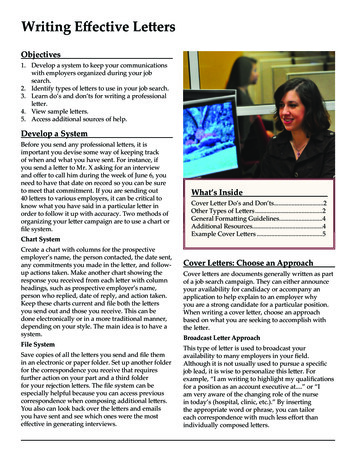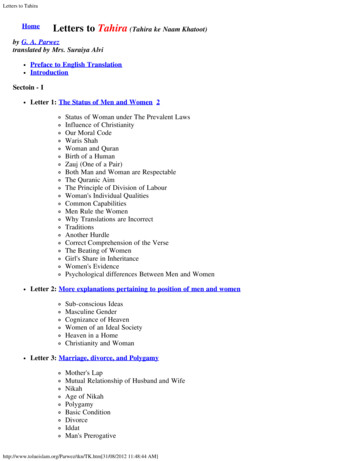
Transcription
Letters to TahiraHomeLetters to Tahira (Tahira ke Naam Khatoot)by G. A. Parweztranslated by Mrs. Suraiya AlviPreface to English TranslationIntroductionSectoin - ILetter 1: The Status of Men and Women 2Status of Woman under The Prevalent LawsInfluence of ChristianityOur Moral CodeWaris ShahWoman and QuranBirth of a HumanZauj (One of a Pair)Both Man and Woman are RespectableThe Quranic AimThe Principle of Division of LabourWoman's Individual QualitiesCommon CapabilitiesMen Rule the WomenWhy Translations are IncorrectTraditionsAnother HurdleCorrect Comprehension of the VerseThe Beating of WomenGirl's Share in InheritanceWomen's EvidencePsychological differences Between Men and WomenLetter 2: More explanations pertaining to position of men and womenSub-conscious IdeasMasculine GenderCognizance of HeavenWomen of an Ideal SocietyHeaven in a HomeChristianity and WomanLetter 3: Marriage, divorce, and PolygamyMother's LapMutual Relationship of Husband and WifeNikahAge of NikahPolygamyBasic ConditionDivorceIddatMan's .htm[31/08/2012 11:48:44 AM]
Letters to TahiraPeculiarity of IslamRepressed WomenLetter 4: Second wifeStory of the PrincessZaidi and SabiraSabira's ThriftinessSacrifice and Hard-workTrials of SabiraSabira's ConditionWho is the Culprit?Letter 5: Incompatible marriagesCustom of Female InfanticideCustom Is Still Alive!Waywardness of RasheedShakira's MotherWeddingEternal SilenceReformationLetter 6: Demands for DowryMatch-making ProblemsDemand for DowryDirty MentalityThe BargainingDower (Meher)Hindu CustomLetter 7: Friction between a Woman and her Mother-in-lawSecrecyDestinyThe ConscienceGod is the SustainerTrust in GodObedience to ParentsThe Quranic Injunction About ParentsThe Quran and Other ReligionsNature of ObedienceMother-in-law ProblemSeparate House for the Newly WedsThe TussleConclusionThe AdviceLetter 8: Education and training of childrenBody and MindEducation of the ChildChild's Nature!Mother's 31/08/2012 11:48:44 AM]
Letters to TahiraImmature MindA Child's Training-groundLetter 9: Concerning ‘hijabQuranic DemandsProblem of VeilHouse ImprisonmentA Secondary ProblemDisplay of AdornmentOutside HouseShowing offPermission to see each otherWhat should we do?The HypocritesOur ConditionThe Need for Right EducationLetter 10: Our Modern WomenLife of a Modern WifeIll-HealthIncrease of Expenses. and This StepWomen's ResponsibilitiesBeing Envious of a ManDuties of Men and WomenEuropean WomenMember of AssemblyPractical ExampleLetter 11: The Importance of Minor Matters at HomeSmall HappeningsSocial Manners at HomeExemplary Righteous WomanPunctualityNot a thing in its placeAbsent-MindedMismanagementCompatibilityLetter 12: Why are our homes are Turning inot a Hell?Deen and ReligionEarly-age MarriageSecond WifeDivorceCriticism On IslamEarly History of IslamCondition of Modern HomesStagnation of WomanLetter 13: Choosing Marriage Partner for m[31/08/2012 11:48:44 AM]
Letters to TahiraSection - IIQuranic Injunctions:1.2.3.4.5.6.7.8.9.10.Status of Man and WomanNikah (Marriage)Dowry (Meher)Strained RelationshipIddatInheritanceProgenyNursing a Child (Breast feeding)Polygamy (More than one wife)ConcubinesSection - IIIAyesha’s Age at the Time of Marriage /2012 11:48:44 AM]
Preface to English TranslationHomePrefaceIn the name of Allah, the Rahman, the RaheemThis book is the English translation of the Urdu book of the same name, written during theearly 1950’s by the great Quranic scholar of the sub-continent, Chaudhri Ghulam Ahmad Parwez.Mr. Parwez’s immense philosophical work is a realization of the desire of Allama Iqbal - therenowned Muslim visionary who developed and propagated a penetrating insight into the nature ofIslam- to study Islam not as a religion but as a Deen, a word which has no parallel in westernlanguages. Mr. Parwez’s studies on the meaning of Deen forms the core of the present work, as wellas his numerous treatises, lectures, discourses and books, including his fascinating exposition on theQuran (in thirty parts), and his modern Quranic Lexicon (in four volumes). His revolutionary writingsand discourses have inspired a widespread intellectual movement in Pakistan, both among theintelligentsia and the common people, and is increasingly influencing similar thinking in othercountries."Letters to Tahira" is essentially a collection of letters written to a mature and inquisitiveyoung lady with clean intellect. This was in response to the queries the author had received frommany of the female readers of his earlier similar book, "Letters to Saleem", which included a series ofletters addressed to the youth of Pakistan and world at large.In this book Mr. Parwez has written exclusively on various matters concerning Muslim girlsand women, particularly in the Indian sub-continent and, in a simple but effective way in the light ofthe Quran, has presented explanations and responses to their worries and concerns.There has been a demand from various circles that this book be translated into English for theEnglish-speaking public in the sub-continent, and the world at large. This task was taken over by oursister in United States, Mrs. Surraya Alvi. The credit for the basic translation goes to her. The bookwas subsequently given to me for review. This was a very difficult task, to say the least. I had totake help from my friend and devoted student of the Quran, Bashir Ahmed Abid. Once the basicconceptual work was done, I was assisted by my colleague Aziz Mamuji, who helped me instreamlining and editing the text. The final draft was scrutinised by Muneer Chughtai, a friend, wellversed in Tolu-e-Islam literature. I hope that the readers will like the work, and I pray that it mayfulfil the purpose it was meant to serve.In the ensuing translation of "Letters to Tahira", we have as far as possible, faithfully renderedinto English the relevant Quranic verses. However, we have avoided giving the Arabic text. They canbe referred to in the Quran by readers themselves. Also, the Urdu poetic stanzas that so effectivelyembellish Parwez's writings have been sparingly used. A few that could be freely translated havebeen attempted.The main objective of this exercise is to be faithful, as mentioned above, to the conceptualmeaning of the text as Parwez delineated it.This book assumes that the reader has a general knowledge about Islam. For our non-Muslimfriends, it is recommended that they study Islam: A Challenge to Religion, written in English by thesame author, to understand the overall concept of Islam.Ubedur Rahman ArainKuwait, June 1996http://www.tolueislam.org/Parwez/tkn/TK preface.htm[31/08/2012 11:49:13 AM]
IntroductionHomeIntroductionIn the name of Allah, the Rahman, the RaheemThe Quran tells us to nurture the up coming young roots, if we want to reclaim or revive adowntrodden nation. If the rationale of our younger generations is properly guided and their desiresand motives are channeled in the right direction, then a nation can certainly rejuvenate itself. Keepingthis reality in mind, my foremost attention has been on the young generation of the nation. Whatever Ihave written is primarily for them. In this regard the "Letters to Saleem" are of special importance.Saleem represents our educated youth who are eager to learn but who, through the wrong educationwhich they get in our schools and colleges, in their minds have doubts and suspicions regardingDeen. The letters tried to dispel these doubts in the light of scientific analysis, Quranic truth andrational wisdom. As such, these letters prove to be quite effective and useful. A while ago, a dearfriend of mine suggested that like the "Letters to Saleem", I start a separate series called ''Letters toTahira'', which should especially deal with problems facing women. This suggestion proved so usefulthat after publishing the first letter, I received hundreds of letters from daughters and sisters all overthe country appreciating and praising this new series. One of the advantages was that the questionsasked covered a wide range of topics, and the rest of the letters published were then based mostly onthese queries.There had been a demand for some time that a collection of ''Letters to Tahira'' be published,like its predecessor book "Letters to Saleem". This book is thus a response to that demand. First Iconsidered including all these letters in one volume, but later I felt that there are other vital mattersthat should necessarily form a part of such of collection. When thinking of other material forinclusion in the book, the need of collating all such Quranic directive that particularly concernwomen, was highlighted. These are now presented in this book, under different headings, so thatwhenever needed one could easily look up the required reference. I have arranged all these laws foreasy reference, but while this has enhanced the usefulness of this collection, it has resulted in a thickvolume. I, therefore, have had to divide it into two volumes.These letters bring forth the trials, tribulations and those vexing problems that the unfortunateand helpless girls of our society have to face today. The solutions to such problems have beenpresented in the light of the Quran. The solutions to these are obviously applicable to the society doesnot correct itself, one cannot get satisfactory solutions to these difficulties. In fact, there are twoeffective ways of making a just society. Firstly, the education in our schools and colleges should bebased on the correct lines and secondly, the laws of the land should be formulated in the light of theQuran. For this purpose it is necessary to awaken public opinion to such an extent that the changescan be effected in a constitutional manner.Through a study of these letters it will be evident that the laws about marriage and divorce, asformulated by the so called Sharia, are often quite contrary to Quranic teachings. Quite often theprevalent Sharia directives, which are sometimes used in legal judgement, contain violations of theQuranic concepts.We are Muslims and our conviction about the Quran is that it is a complete code of life givento us by Allah. Therefore, anything that goes against the Quran cannot be correct. What we need is tobring our Sharia to completely conform to the Quran, and this can be done by applying the approachmentioned above.Some letters highlight those maladies that are currently rampant amongst our modern educatedclass. These are the results of following the 'West' blindly. The nation is gradually being pushedtowards destruction, and if the orthodox section of the society needs to change, the modernists, too,are not to be exempted. If the former is a patient of paralysis, the latter has had a stroke. It ishttp://www.tolueislam.org/Parwez/tkn/TK Introduction.htm[31/08/2012 11:49:33 AM]
Introductionimperative that both extremes be brought to the middle path, in the light of the Quran.Sex is a very important subject because it is deeply linked with civilization and the culture ofa nation. Precious little has been written about this subject, and so I want to talk about this in amanner which explains its importance. With this aim in mind, a research paper on this subject hasbeen included in the second part, which explains why the Quran emphasizes chastity and the purity ofthought and deed.It is a fact that women can 'train' a society more easily and effectively than men. Societyconsists of an aggregate of different families, and it is a woman who can effectively and beautifullyset her home right. The publishing of these letters will hopefully initiate the reformation process athome. If this effort of mine can light a few Quranic candles in some homes, I believe my endeavourswill have borne fruit.To those sisters who want to start elementary Quranic education in their homes, I wouldsuggest to them my book "Islami Muaashrat" which is available in English from Tolu-e-Islam Trust,under the title 'Islamic Way of Living'. Children should be made to study it, lesson by lesson, andthen be encouraged to practice it accordingly. This book, in an easy and attractive style, portraysQuranic guidance on aspects that concern our everyday life. Thereafter, girls can go on to study"Tahira Kay Naam" and both male and female college students can read "Saleem Kay Naam". Thesewill give their thinking an Islamic foundation.Finally, I should emphasize that I would love to satisfy any doubt or answer any questionregarding any subject discussed in these letters. For me, every girl of our nation is my daughter"Tahira."ParwezJanuary 1957, Karachi(Second Edition)Preface to the Second (Urdu) EditionThe first edition of this book was published in two volumes. This second edition, with changes by theauthor, is being published in one volume. All concerned aspects have been covered in their entirely.Gulberg, Lahore.Nazim, Idara Tolu-e-IslamApril 1969, (Second Edition)Preface to the Fourth (Urdu) EditionThe fourth new edition of this book includes the last letter to Tahira which Mr. Parwez wrote in June1984. This brings together the Quranic education, on aspects which our sisters and daughters have toface in their married lives.February 1989http://www.tolueislam.org/Parwez/tkn/TK Introduction.htm[31/08/2012 11:49:33 AM]
First Letter to TahiraHomeStatus of Men and WomenFirst Letter to TahiraDear daughter Tahira,May you have a long life! I want to bless you with a wish that you may happily live to see yourprogeny flourish and prosper. Firstly, you will ask what this wish means. Even if I tell you that it isan affectionate blessing, you will ask the meaning of 'blessing.' If one has to ask for such a meaning,the wish loses its charm and effectiveness. A blessing, a subtle humour, and a melody or verse areeffective only when they are spontaneously understood and absorbed. If you have to explain theirmeanings, they lose their spicy charm.Daughter, I do appreciate all your complaints but whenever I write to Saleem, I always mean that youare included, too. I did not think of you and Saleem separately. But now I know that you are sensitiveabout it, and consequently I have keenly felt your special sarcasm that I, too, like other people, prefera son to a daughter and consider a man better than a woman. No Tahira, you have misunderstood.This is simply beyond my imagination, but your sarcasm reflects depth of your vision and sensitivityof your feelings. I appreciate this, because I know if a woman's worthy emotions are not valued, howdangerous she can become. Listen dear daughter, do not ascribe a wrong meaning to this word'dangerous'. It should be understood in the context I use it. I believe it is not difficult for you tounderstand the correct meaning of my words, since you have been hearing them a long time. A basicreason for the incompatibilities that have crept into our Muslim society is that man has disregardedthe respect-worthy emotions of woman. It is a fact that he has never tried to understand woman. Hehas never considered her worthy enough of being understood. But has this neglect given him anypeace? If your left eye is aching, can your right eye sleep peacefully?Status of Woman under The Prevalent LawsTahira, in your mind you have quite easily concluded that since the "Sharia Laws" (Religious Laws)have been formulated by men, they give them an upper hand and tend to suppress women. There isno doubt that our prevalent ''Sharia Laws'' would result in the same mess. However, the reason is notas you have understood it. If we consider your reason to be correct, then men 'by nature' are such thatthey want an upper hand and want to overpower and enslave women. If you remember, I hadanalyzed this fact in a letter to Saleem, that there is no such thing as 'human nature'. What we call'Nature' consists of something that he has brought along from his animal life. As far as animals areconcerned, you never see a male keeping an upper hand over his female. As such, men cannot havethis streak because of their animal instincts. Besides animal instincts, the qualities that manifest in'human nature' are in fact the result of heredity, circumstances, education and nurturing. Therefore, itwould be incorrect to claim that because our ''Sharia Laws'' have been made by men, they have givenwomen a degraded position in them. Instead, it would be more appropriate to say that these laws hadbeen formulated under such circumstances when tyranny, instead of justice, was the order of the day.At that time, the 'woman' was hated. Hence, according to these laws and ideas, a woman's status wasthat of a down-trodden, enslaved and degraded being. These laws relate to our monarchical periodand, as I have often repeated before, our prevalent 'Islam', too, was more or less formulated at thattime. Life in this period, whether it concerned men or women had coercion as its prominent feature.For example, all the laws formulated at that time reserved all the rights for the ruling class. The ruledhad no rights; they could only beg for the royal benevolence. They could not demand anything as ofright. According to these laws, the landlord had all the rights, and the tiller of the land was treated asa servant. According to these rules a rich man could get all the luxuries whenever he wanted, and thepoor received even their daily bread as a charity. In fact the poor got something, too, but this wasonly to save the giver from the influence of the evil eye.http://www.tolueislam.org/Parwez/tkn/TK 01.htm[31/08/2012 11:50:02 AM]
First Letter to TahiraSo much so that according to these beliefs, a rich man could buy his paradise with his money, but apoor man had to cry and beg for his salvation.It is so obvious, therefore, that in an environment where such laws and beliefs have been devisedeven for male subordinates, a woman cannot expect better treatment.Influence of ChristianityIn addition to tyranny, men were full of contempt for women when they made these laws. This had aparticular reason.As I have indicated on several occasions, our prevalent Islam is made up of the customary practicesof Jews, the racism and personality cults of Zoroastrians, and the monasticism and priesthood of theChristians.Christian priesthood had a very unwholesome image of woman. They believed that a woman was thesource of all evils, because she was the reason behind poor Adam being expelled from paradise. Shewas regarded as a demon, because evil existed in the world due to her. Christianity thus regardedwoman as the embodiment of all evils, and was, therefore, fit to be abhorred. Based upon this image,Christ's life of celibacy was regarded as the best model. The Christians went so far as to say that awoman did not even have a soul.This reminds me of an interesting anecdote. We had a man named Prem Singh in our village, whopracticed indigenous medicine. He took care of both humans and animals. Once mother had kidneypain and she wanted Prem Singh to prescribe some treatment. He said, "You do not have kidneypain." Since she had suffered this malady many times before, she insisted that it was her kidneyaching. On hearing this Prem Singh said, "No Aunty, you do not have kidney trouble because womendo not have kidneys." He presumed that men were the only ones having hearts and kidneys. Whatcould mother have said to this quack? She just said to him, "Prem Singh, butcher Mohammad Deenslaughters a she-goat daily, and she has two kidneys just like a he-goat." Prem Singh replied, "Auntyit is different with a she-goat."As I was saying the hateful Christian image of a woman filtered into Muslim society, too. Thishappened in the above mentioned cruel society. This was the period in Islamic Culture, during whichwomen were auctioned in the market to be made into concubines, and everyone was free to buy andsell as many as he wanted, whenever he wished to. This business was legitimate according to Sharia;and is still so by the Sharia practiced by 'Mullahs'.These were the circumstances under which ''Sharia laws'', were formulated, and which today arecalled 'Islamic'. To look for human dignity or actual status of women in these laws, is to deceiveoneself. To justify these laws or to make them appear authentic, claim such as the following havebeen concocted: A woman has a defective mind; she was born out of Adam's rib, so like the rib shewill remain crooked and if you try to straighten her, she will break but will not become straight; anation which allows a woman's opinion in matters of state and public life would perish; and so on soforth.Our Moral CodeOn the basis of these beliefs and regulations, when a code of ethics was formulated, women weredegraded in it as the following couplets read:If a woman had a righteous character then she would not be called Zan (which means tobeat), but would be called Mazan (meaning do not beat).http://www.tolueislam.org/Parwez/tkn/TK 01.htm[31/08/2012 11:50:02 AM]
First Letter to TahiraWhat a good thing it was that Jamshed said to his companion, that a woman's properplace is either behind the veil or in grave!Remain alert even if you have a good woman. One's donkey should be tied securely, foreven a friend could be thief.If you want to hear something in more explicit words, then listen to the Heer of Waris Shah whichreflects the society of Punjab and is always quoted like the Quran. I could have sent you a fewrelevant couplets, but the irony is that if I write some Persian verses, then I have to translate them;and if I say something in your own language, then I have to explain it as well. I do not understandwhat your schools and colleges are making of your generation? You forget your own language, andyou do not learn any other well enough to be able to enjoy it. At least your generation is stilltolerable, but I cannot say how the next one is being mould. But I forget, you and your generation arewhat we have made; and the future generation, too, will be whatever we will make of it. No one canblame the future generations. The behaviour of children reflects their training, or the lack of it.Waris ShahIf a father wants to recite the writings of Waris Shah to his daughter, this could be embarrassing forhim. Waris Shah's softest narration for women is that they are "Kanyan" of deceit. The word warrantsa bit of analysis. In Surah Al-Yousuf, the famous quote of Zulekha's husband has been mentioned:These women are superb manoeuvrers (12:28). However, we present this saying as if God ordained itHimself. If ever you discuss women, somebody would immediately close the argument by saying, "Itis futile to discuss women as God Himself has said: These women are superb manoeuvrers (12:28)."As such, no more reference is needed. Waris Shah, too, brands them as "deceitful" by following this'revelation' of God. The word "Kanyan" (in Punjabi and Urdu) is essentially derived from an Arabicword "Kaida Kunna". It is, however, a very comprehensive word. You must have seen the cactus,called "Aak" (in Punjabi), generally found in the villages. It bears a fruit which looks like a mango,but which is extremely bitter. Its slightest touch on the tongue can make your whole mouth bitter; if alittle gets into the eye, it can turn you blind. This is how you describe a "Kunni". It shows how adeceitful "Kunni" can be, and this is the picture of a woman as presented in our society. She lookslike a fruit of paradise, but is extremely poisonous!This was quotation from Waris Shah who is considered as representing the shallow section of oursociety, but how about the educated class of our people. They even present statistics to prove that awoman is stupid, uncouth and uneducated. In the first place, for ages you deny woman any access toknowledge, then you present her as uncouth and raw material to prove your point. Remember howfrom infancy Chinese girls were made to wear iron shoes, and when their feet did not grow, theywere presented as proof that they could not even walk. (Before the Revolution it was customary tobind the feet of Chinese women, so that their feet could not grow, thus making it difficult for them towalk.)Woman and QuranAll of these, dear daughter Tahira, were the results of the above mentioned laws and moral codes,which were the product of times mentioned above. However, the Muslim criteria of fixing the statusof a woman, or man, are neither these social laws nor this moral code. For the Muslims, there is onlyone standard under the sky, and that is the book of God, which they profess to believe in. What statusdoes the Quran endows for woman? The details are lengthy, but their gist reminds me of a jokewhich Allama Iqbal used to relate. He would say, "If I were not a Muslim, and I had studied theQuran like an ordinary student, then I would have concluded that this book was written by a woman,who was taking revenge on man, for the usurped rights of her community". If one studies thereligions and cultures of the world, it leaves no doubt in one's mind that a woman has been pushed toextreme degradation. On the other hand, in the Quranic study it appears as if she has been favouredhttp://www.tolueislam.org/Parwez/tkn/TK 01.htm[31/08/2012 11:50:02 AM]
First Letter to Tahiravery much. For a start, the Quran has rejected the common belief that God created man (Adam) firstand then woman (Eve) was created out of his rib. By now, you must have understood that accordingto the Quran, this very concept that human beings were created by a special couple called Adam andEve, is wrong. The Quran, in effect, presents Adam as the representative of mankind or humanity.Birth of a HumanThe theory of evolution tells us that life began with a single cell that later divided itself into two i.e.an ovum and a spermatozoon. The Quran corroborates the same by saying: God created you from asingle life cell and from it created its mate (for man a woman and for woman a man) and from themtwain (4:1). In other words the single life cell swelled and divided itself into two and this continueduntil then a great number of men and women inhabited this world. And from them were createdmany men and women (4:1). You should note that the Quran does not discriminate between men andwomen by virtue of their genders. Their life source is the same, and they are like two branches of thesame origin.Zauj (One of a Pair)The Quran calls both man and woman as Zauj; but in Urdu we call a woman the Zauja of a man. Wedo not call a man the Zauj of a woman. The Quran, however, calls both man and woman, Zauj toeach other, meaning companions. Further, it does not say that the woman is a man's Zauj, and that theman is not. God addresses human beings and tells them: He has made Zauj among you (30:21,42:11). Zauj means a friend and companion; which implies that men and women are each other'sfriends and companions. Accordingly, Zauj would mean the ones who are complementary to eachother. Given this meaning, a man complements a woman, and a woman complements a man. Theyare Zauj to each other. The Quran has gone to the extent of saying, you are from each other (3:195).Therefore, no individual can call itself complete unilaterally.After this, the Quran has negated the myth that 'Adam had faltered in the paradise due to a woman'.The belief of Satan trapping the woman and then the woman tempting Adam, who sinned and wasthen kicked out of paradise was rejected as has been mentioned in Torah of Jews. The Quran saysthat both man and woman are capable of compliance or defiance of laws; both can err and commitmistakes. Therefore, it said: Satan misguided both of them (2:36). Hence it is wrong to surmise thatwoman is responsible for all the sins committed in this world, and that the man is completelyinnocent.Both Man and Woman are RespectableHaving seen the negative stance, let us explore the positive angle. The Quran ordains: Verily We havemade humankind worthy of respect (17:70). This reference is not only for man, but for woman also.In the norms of the Arabic language when one wants to mention both men and women together,would say "Bani so and so". In the Quran, "Bani Israel" does not mean only men of Israel, but bothmen and women. Similarly when the Quran tells us: We created humans with aesthetic balance(95:4), this includes both men and women. The Quran always collectively addresses human beings,and not just men.The Quranic AimBy the way this point should make you understand the aim of the Quran, viz.:(i) To develop human potentialities and to harmonize them in a balanced way. (Balance here meansthe appropriate and proper weight. Whatever weight anything is supposed to have, it should have justthat. Everyone knows the importance of the exact or the correct weight of an ingredient in a rwez/tkn/TK 01.htm[31/08/2012 11:50:02 AM]
First Letter to Tahira(ii) The society in which people have to deal with each other should be balanced;(iii) Humans and the forces of nature should also strike a harmonious balance.In other words, the purpose of human life is to establish a balance. Now, when in the Quran humanlife refers to both men and women, is it possible that we can achieve this balance with only onegender (either men or women alone)? Can you imagine maintaining this balance by ignoring half ofhumanity altogether? A basic reason for all the imbalances in human life is the consideration of halfof humanity as a whole. This deprives us of the benefits of a balanced way of life, as in general itremains incomplete.This ignorance goes a step further. The half (which man considers as being human), has been furtherdivided and sub divided to such an extent, that the very self of ninety-nine percent of humans hasbeen discriminated against. Only those who belong to the "upper strata", according to their self-madenorms, are considered humans. This i
Deen. The letters tried to dispel these doubts in the light of scientific analysis, Quranic truth and rational wisdom. As such, these letters prove to be quite effective and useful. A while ago, a dear friend of mine suggested that like the "Letters to Saleem", I sta
